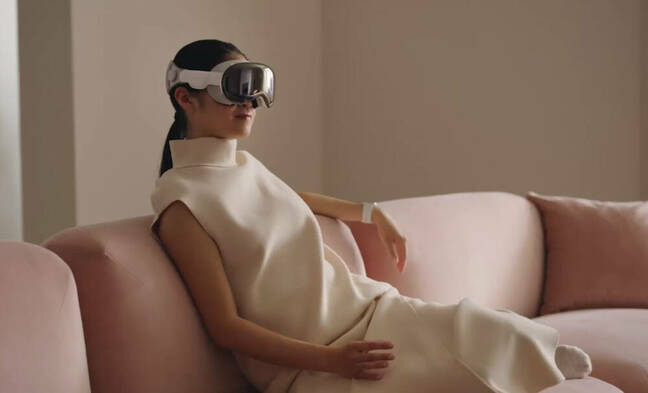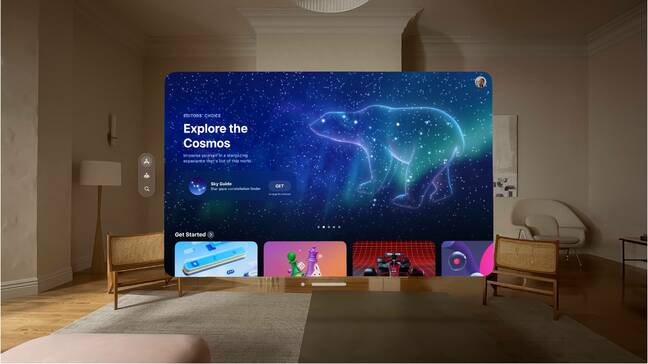Metaverse? Apple Thinks $3,500 AR Ski Goggles Are The Betterverse
WWDC For its annual Worldwide Developers Conference, Apple today teased an augmented-reality headset called Vision Pro, its second-major product line expansion after the Apple Watch since CEO Tim Cook took charge in 2011.
"This is a day that's been years in the making, one that I've really been looking forward to," Cook told his audience. "I believe that augmented reality is a profound technology. Blending digital content with the real world can unlock experiences like nothing we've ever seen.
"Vision Pro is a new kind of computer that augments reality by seamlessly blending the real world with the digital world. It's the first Apple product you look through and not out."
As well as the ski-mask-like virtual-reality goggles, Cook announced a 15-inch MacBook Air, renovated Mac Studio and Mac Pro desktop computers, iOS 17, iPadOS 17, and watchOS 10.
Apple's refreshed hardware includes Arm-compatible Apple Silicon M2 chips across much of its range. And with the arrival of Apple Silicon in the Mac Pro, Apple's platform transition away from Intel chips is complete. The previous Mac Pro relied on an Intel Xeon processor; now, none of Apple's current hardware has Intel inside. The x86 giant's stock price is right now down about five percent on the news.
Another reality
The Apple Vision Pro headset starts at $3,499 and is scheduled to ship early next year. The face-hugging gadget – like something out of Ready Player One – and dangling battery aspire to define a platform that Cook calls spatial computing – carefully not mentioning the M word.
Demonstrations of the snorkling-goggles-esque device show it as an entertainment system – with vivid video and spatial audio – and as a work environment – with layers of icons, windows, and menus, making it more of a general computing device if that's what you want. It features an input system tied to the user's eyes, hands, and voice – internal sensors track eye movements while external cameras watch for hand gestures and microphones capture voice commands.
Vision Pro runs on visionOS, which includes iOS and spatial frameworks, a multi-app 3D engine, an audio engine, a devoted renderer subsystem, and a real-time operating system.
The device will have it own app store, although it's anticipated many existing iPhone and iPad apps will work with the new hardware. We're told the device will launch with support for Disney+, the Unity game engine, and tons of iOS and iPadOS applications, including Safari and Microsoft's Word and Excel. Thus Apple gets to exploit its vast ecosystem of third-party software to kickstart its VR headset line: there's already a load of programs ready for it.
The hardware will provide face-based authentication using a system called Optic ID, which is supposed to be harder to fool than Apple's usual Face ID, we're told.
The battery pack, which hangs off the goggles, is supposed to last a couple of hours per charge, although you can keep the device plugged in while using it. We're quite surprised by that dangling dongle on a Cupertino product: it looks odd, and may get annoying, physically and in terms of limited run-time.
Eye, eye
Among the headset's many innovations – Apple is said to have filed more than 5,000 patents developing its headset – Vision Pro manages to avoid the antisocial effrontery of other goggle systems that conceal the wearer's eyes. The company calls this bit of trickery EyeSight.
Apple's hardware captures an image of the user's face during setup and projects a likeness of the wearer's eyes on the headset's external display to create the illusion of the wearer's gaze when needed. This realistic-looking fake face can be revealed when another person is nearby, as a form of social solicitude, and can be hidden by altered opacity when the wearer's attention is elsewhere.
- By 2026, total AR/VR goggle sales will trail a single quarter of current tablet shipments
- Meta wheels out Deloitte to plug the metaverse. Is anyone actually convinced?
- Surprise! The metaverse is going to suck for privacy
The two internal displays together have 23 million pixels, which provide resolution better than a 4K monitor per eye. They're driven by an Apple-designed M2 processor and a new R1 real-time sensor processor that coordinates input from 12 cameras, five sensors, and six microphones. The R1 chip ensures display changes due to head movements and other input occur with as little motion-sickness-inducing latency as possible – within 12 milliseconds, Apple claims.
In a move to distance itself from companies in the VR space that treat headset analytics data as something that can be sold to marketers, Apple is promising not to reveal eye tracking data.
"Where you look is very personal," explained Mike Rockwell, VP of Apple's technology development group, during the WWDC presentation. "It can give away what you're thinking. In Apple Vision Pro, where you look stays private. Eye input is isolated to a separate background process so apps and websites can't see where you were looking. Only when you tap your fingers do results get communicated."
In other words, data from cameras and sensors is processed at a system level and is not available to apps, meaning they can't covertly capture your surroundings.
Accessorize
The Vision Pro's non-electronic parts have also received Apple-level attention. Attachable Zeiss glasses will be offered to handle vision correction, if necessary. A so-called Light Seal – a piece of fabric that fits to your face to keep out stray light – is separate from the aluminum alloy frame and will be available in varying sizes, as will the Head Band to ensure a snug fit. The fact that Apple has chosen to capitalize these accessories means different styles are likely to be sold, and they most likely won't come cheap.
Apple is entering the face-hugging computer market in the wake of Meta's widely noted metaverse cash conflagration – $13.7 billion in operating losses for its Reality Labs division in 2022, following $10.2 billion spent in 2021 – and subsequent layoffs. For those who remember 2015, Google also set a fair bit of cash alight with its failed augmented reality headset Google Glass, which lived on for business customers until recently.
And how could we forget Microsoft's HoloLens – well, everyone else has.
Nonetheless, analysis firms that sell expensive reports to tech industry clients continue to talk up the market potential of augmented, virtual, mixed, and extended reality. For example, Acumen Research and Consulting said last December that the global AR/VR market, $22.5 billion in 2021, will reach $451.5 billion by 2030.
“Even though it won’t launch until early 2024, we expect that the Vision Pro will transform the spatial computing segment, thanks to some of Apple’s design decisions and its innovative visionOS," said Leo Gebbie, principal analyst for connected devices at consultancy CCS Insight, in an emailed statement. "Virtual and augmented reality (VR and AR) have been through a period of intense scrutiny and skepticism in recent times but if one company has the star power to revive the segment, it’s Apple."
There's still some life in the market. Microsoft's HoloLens 2 continues to exist. Magic Leap 2, after much trouble, debuted in September, and also exists. And Meta just announced its $499 Quest 3 headset.
Apple's arrival is likely to be spun by concerned competitors as a validation rather than a setback. Now the maker of shiny things just has to figure out how to build a follow-up headset that the masses can afford. ®
From Chip War To Cloud War: The Next Frontier In Global Tech Competition
The global chip war, characterized by intense competition among nations and corporations for supremacy in semiconductor ... Read more
The High Stakes Of Tech Regulation: Security Risks And Market Dynamics
The influence of tech giants in the global economy continues to grow, raising crucial questions about how to balance sec... Read more
The Tyranny Of Instagram Interiors: Why It's Time To Break Free From Algorithm-Driven Aesthetics
Instagram has become a dominant force in shaping interior design trends, offering a seemingly endless stream of inspirat... Read more
The Data Crunch In AI: Strategies For Sustainability
Exploring solutions to the imminent exhaustion of internet data for AI training.As the artificial intelligence (AI) indu... Read more
Google Abandons Four-Year Effort To Remove Cookies From Chrome Browser
After four years of dedicated effort, Google has decided to abandon its plan to remove third-party cookies from its Chro... Read more
LinkedIn Embraces AI And Gamification To Drive User Engagement And Revenue
In an effort to tackle slowing revenue growth and enhance user engagement, LinkedIn is turning to artificial intelligenc... Read more



